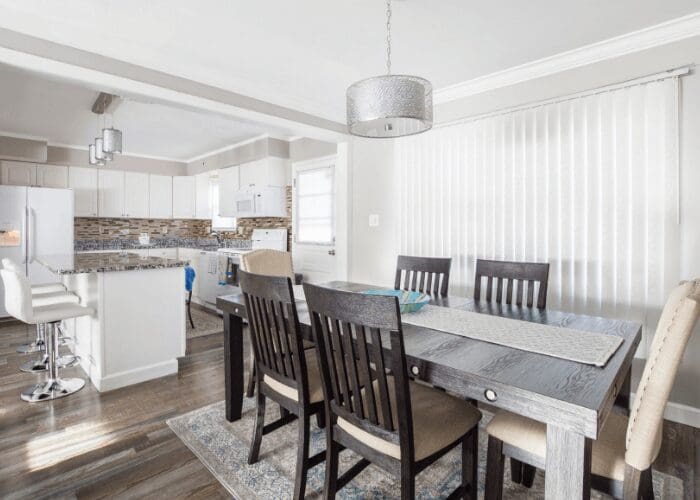DIY Home Staging Tips That’ll Transform Your Space Into a Showplace
- Published on
- 5-7 minute read
-
 Christine Bartsch Contributing AuthorClose
Christine Bartsch Contributing AuthorClose Christine Bartsch Contributing Author
Christine Bartsch Contributing AuthorFormer art and design instructor Christine Bartsch holds an MFA in creative writing from Spalding University. Launching her writing career in 2007, Christine has crafted interior design content for companies including USA Today and Houzz.
Flip through the catalog of any home goods store and you’ll see photo after photo of perfectly appointed living spaces. Those picturesque vignettes are strategically designed to entice you into buying the showcased ottomans, end tables, and other decor. These same, clever DIY home staging tips will also do the trick to sell your own home faster and for more money.
Homes that have been deep cleaned, depersonalized and staged help potential buyers focus on the house rather than its current occupants. Just ask top real estate agent Dawn Krause, who ranks at #2 out of 1,475 seller’s agents in St. Louis County, MO:
“I’m a huge advocate of staging. The look of the home is so important. Buyers overall do not have vision. Without staging, they have a hard time envisioning their own family and their own things in the home.”
Home staging is an essential tool that transforms your house into an inviting showplace that will attract the most potential buyers. According to the National Association of Realtors’ (NAR) 2017 Profile of Home Staging, 77% of buyers say that staging helps them see a house as their future home.

A home that’s been decked out like a department store has benefits for the seller as well. The NAR’s 2017 Staging Profile reports that 62% of sellers’ agents say that staged homes sell faster. And the NAR’s research from 2015 indicates that buyers are willing to pay more for a well-staged home, too.

Staging a home to sell isn’t the same as decorating it to appeal to your own preferences. It’s both an art and a science that might just require the assistance of a professional stager. That help doesn’t come cheap: it can cost an average of $1,390 to $1,750 to stage multiple rooms, depending upon whether the house is occupied or vacant.
But staging doesn’t have to break the bank. If you have a good eye for color and design, you may be able to do the staging yourself. Just make sure you’re redecorating the rooms in a neutral design style and color palette so that your home appeals to the largest pool of buyers.
Let’s take a look at how to transform each room of your home into a staged showplace.
DIY Home Staging Tips: Cozy Kitchen
Whether you’re cooking up a family meal or just hanging out for a cozy chat, there’s no question that the kitchen is the hub of the home. In fact, Forbes lists the kitchen as one of the top two rooms that will make or break your home sale.
When it comes to the kitchen, Krause advises her clients, “For open houses, I love it when the sellers make some good-smelling brownies or blueberry muffins or something like that just to elicit more of that warm, homey feel.”
Tempting scents are a great way to make potential buyers at feel at home in the kitchen, however, appealing to their eyes is most important.
Unfortunately, unless you’re going to invest in remodeling (link to Kitchen/Bath Makeover article), your kitchen is what it is. Sure, you can repaint the walls and add a backsplash, but you cannot relocate the appliances or rearrange the layout of the cabinets to make the space appear larger or more inviting.
Since you can’t move the big stuff, will staging really help? Absolutely.
In the kitchen, staging focuses on creating vignettes. A vignette is a grouping of eye-catching objects arranged to create a pleasing picture. Think of it as a sort of still life arrangement that an artist might paint or photograph. The easiest way to master the art of designing vignettes is to follow The Rule of Three.

This interior design concept is just as simple as it sounds—objects grouped in threes are more pleasing to the eye. That’s why an interior designer might hang three pendant chandeliers over a kitchen island when two would’ve given sufficient light.
Follow this rule when staging your own kitchen to create stylized vignettes on your countertops. For example, hang three matching towels on your stove or pair your pretty salt and pepper shakers with a decorative olive oil decanter.
Using the Rule of Three doesn’t mean you can keep any old thing on your countertops, though. Cramming your blender, toaster and standing mixer together in a corner does not make an attractive vignette. Instead, tuck small appliances away and replace them with decorative pieces, such as a fruit bowl.
So, how does a lone fruit bowl follow the Rule of Three? By being an odd number. You see, while the number three is often the “charm” when creating vignettes, groupings of five, seven and even one work, too, depending upon the size and variety. For example, place five apples in the fruit bowl and it’ll look full and styled, but take one away and the four remaining apples look sad and lonely.
Of course, the Rule of Three doesn’t just apply to the number of objects, it can apply to other things, too. For instance, categories of objects—like placing apples, oranges and bananas (three types of fruit) in the bowl.
Make Your Living Room Lively
There is also a good choice when it comes to the number of colors you bring into a space like the living room. However, you shouldn’t introduce them in equal amounts or they’ll fight for attention. Instead, follow the interior design principle known as The 60-30-10 Rule.
With 60-30-10, you’re introducing three colors into the living room by percentages. In most cases, your wall color and one or two other items, like an area rug, will be the dominant hue, amounting to 60% of the color in the space. The furniture is often the secondary color, making up another 30% and the final 10% comes from a third accent hue that brings brightness into the room.

When you’re designing to sell, your dominant, 60% color should be a neutral hue—like white, beige or gray—that complements your existing furniture color. For example, in this image the white walls and sofa make the blue furniture and accessories appear crisp and cool, while the small moments of yellow add a warm pop of color.
Once you’ve got your 60-30-10 color story worked out, use the Rule of Three to create attractive vignettes on the living room’s tables and shelves. Just remember, decluttered houses sell better so you only want a few vignettes to keep your house from looking too bare and empty.
The best way to keep from over-cluttering is to map out a few places for vignettes in each room. Create a list of what pieces you’ll need and try to keep it short. For example, you’ll only need two more items to create a three-piece vignette starring your end table lamp.
Once you’ve got your list, go “shopping” for decorative accessories throughout your whole house to find a select few pieces that work well together. Pack away anything that doesn’t make the cut—especially your most distinctive decor that shows off your family and your personality. That way the focus stays on your house and not on your knickknacks.

A Functional Formal Dining Room
Which came first—the death of the dinner party or the end of formal dining rooms? No matter how it happened, formal dining rooms aren’t common anymore in the open floor plans of modern houses. So if your home has one, it can be a drawback for some buyers.
So how do you sell a house that has a whole room of wasted space? With staging, naturally.
A well-staged formal dining room will get potential buyers excited about the idea of hosting their own parties in the space. To make this happen, you simply need to set the table.
Look over your existing dining set for any stains or damage to the woodwork. If you’ve got grungy seat cushions or scratched finishes, hide them with tablecloths, table runners and chair covers in a color that complements the wall color and your china.
Next, Break out your best dishware, polish up the fancy silverware, invest in fancy cloth napkins and lay out a properly positioned place setting for every seat around the table. Of course, the place settings are one part of your tablescape.
When you’re choosing a centerpiece that needs to last through the open house and multiple showings, fresh flowers simply won’t do. Replacing the bouquet every other day isn’t worth the effort or expense. Instead pick a low-maintenance, non-floral centerpieces like a grouping of three succulents of varying heights or glass jars filled with seashells.
If your dining table is too small to fill your dining room, don’t despair—staging can make the extra space appear useful. For unused corners, simply bring in a small table and stage it as a bar cart with bar glasses and decanters. If your extra space is longer, introduce a narrow buffet table and “set” it with covered serving dishes and a smaller centerpiece that complements the tablescape.

Ask: Is My DIY Home Staging Outstanding?
Once your kitchen, living room and dining room are ready, how can you tell if your staging will appeal to buyers?
Rather than trusting your own style judgment alone, it’s best to review your redesign plans and results with your real estate agent. If your realtor isn’t convinced that your DIY staging will do the trick, it may be time to get a second opinion from a professional.
For between $150 to $400 you can get a one to two-hour consultation from a professional stager who knows what colors and styles are most attractive to local buyers. Although they won’t do the staging for you during the consultation, you will get an expert opinion on what you’ve done right and what areas still need work.
Whether you do the work yourself or hire a professional, one thing is certain—-staging will definitely help your house sell.
